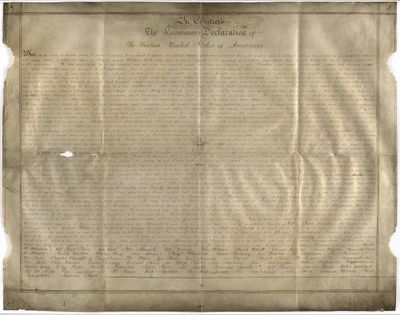Spin Control: A Yankee Doodle trivia quiz

On July Fourth, Spin Control gives its readers a chance to prove they are the Yankee Doodlest of dandies with its annual Independence Day Trivia Quiz. Some are things everyone who bleeds red, white and blue should know, and a few things are, well, trivia.
You can decide for yourself which is which with these 13 questions – one for each of the original colonies.
1. If you are celebrating July Fourth with fireworks (and if so, check local laws first) you are participating in a custom that goes all the way back to:
A. Medieval England
B. Ancient China
C. Ancient Rome
D. Ancient Egypt
2. The opening line of the Declaration of Independence is
A. We the people of the United States…
B. When in the course of human events…
C. We hold these truths to be self-evident …
D. Government of the people, by the people and for the people…
3. John Hancock has the largest signature on the Declaration. What was his role at the Continental Congress?
A. President
B. Secretary
C. Parliamentarian
D. Treasurer
4. The Declaration lists life, liberty and the pursuit of happiness as inalienable rights. The Bill of Rights says a person can’t be deprived of life, liberty or what without due process.
A. Limb
B. Speech
C. Property
D. Rights
5. Thomas Jefferson wrote the first draft of the Declaration, but before being presented to the Continental Congress it was revised and edited by a committee of which he was a part. Of the following, who was not on that committee?
A. John Adams
B. Benjamin Franklin
C. James Madison
D. Robert Livingston
6. Of the 56 people who signed the declaration that all men are created equal, how many owned slaves?
A. About a fourth
B. About a third
C. About half
D. More than two-thirds
7. When the declaration was signed in 1776, how many of the colonies had outlawed slavery?
A. 0
B. 1
C. 2
D. 4
8. The first 10 amendments to the Constitution are known as the Bill of Rights. As originally written, how many were there?
A. 8 – two were added later
B. 10 (duh)
C. 12 but two didn’t pass
D. 13, but freedom of press, assembly and religion were combined into the first one
9. Which of the following was not one of the original 13 colonies?
A. Rhode Island
B. Georgia
C. Alabama
D. Connecticut
10. The Declaration of Independence and the U.S. Constitution were both written during gatherings in what city?
A. Philadelphia
B. Boston
C. New York
D. Charleston
11. The gathering for the Bill of Rights was in what city?
A. Philadelphia
B. Boston
C. New York
D. Washington, D.C.
12. For what purpose did the Constitution say slaves should be counted as three-fifths of a person?
A. For voting, so that every five votes would only count as three.
B. For taxes, so that slaves would only pay 60% of the taxes as a free person.
C. For congressional representation, so slave states would have more members of the House.
D. For punishment, so that a slave wouldn’t serve more than 60% of the time in jail as a free person for the same crime before being returned to his owner.
13. How did George Washington’s troops celebrate Independence Day on July 4, 1778?
A. They mounted a surprise attack on the British in Trenton.
B. They got a double ration of rum.
C. They shot off fireworks.
D. They cooked sausages over campfires and had the first hot dog eating contest.
Answers
1. B. China invented gunpowder, and eventually someone said “Let’s build something that goes up in the air, explodes and starts a bunch of fires.”
2. B. Although C. is in the Declaration a few lines later.
3. A. Hancock was the president, which is likely why he signed his name so large.
4. C. Property would include money for fines.
5. C. Madison would later write the Constitution but wasn’t at the Continental Congress.
6. D. By some accounts, 41 of the 56 owned slaves at some point.
7. A. Pennsylvania was the first state to begin outlawing slavery in 1780.
8. C. The first two didn’t pass with the rest, although the amendment to limit raises while in Congress, passed almost 203 years later.
9. C. Alabama became a state in 1819.
10. A. Both happened in Philadelphia.
11. C. It was written by the First Congress, which met in New York City, the nation’s temporary capital.
12. C. They couldn’t vote, but they were counted in the census, allowing rural Southern states to remain relatively close to the number of northern representatives for many years.
13. B. Among his other accomplishments, Washington was relatively famous in his day for his rum punch.